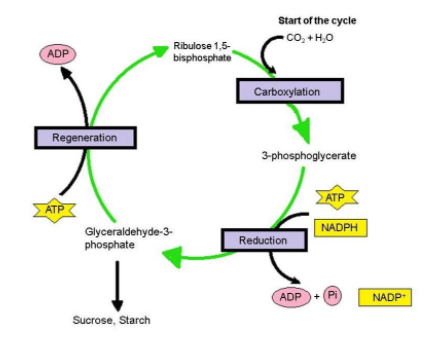Answer
415.2k+ views
Hint:This is the process by which plants convert light energy into chemical energy. Utilization of $CO_2$ takes place during this process.
Complete Answer:
Autotrophic organisms have the capability to transform atmospheric $CO_2$ to a reduced state i.e. carbohydrate and, this process is known as carbon fixation or carbon assimilation. All the photosynthetic eukaryotes, from the most primitive alga to the most advanced angiosperm, reduce $CO_2$ to carbohydrate through the same basic mechanism.
Contribution of Melvin Calvin: The complete biosynthetic pathway of photosynthetic carbon reduction cycle was for the first time elucidated by Melvin Calvin in and his colleagues in the 1950s that is why it is called the Calvin cycle. He inserted the radioactively labelled carbon (14C) into photosynthetic algae and analysed the pathway of carbon fixation in the plant by the method of two-dimensional paper chromatography. For this work he was awarded the Nobel Prize in 1961. He discovered that the first stable product formed during the process of carbon fixation is a 3-carbon organic acid, namely, 3-phosphoglyceric acid (PGA). Thus, it is also called the C3 cycle.
Three phases of Calvin cycle: The Calvin cycle proceeds in three stages –
1. Carboxylation: In this stage $CO_2$ and water from the environment enzymatically combine with a 5-carbon compound, Ribulose-1, 5-bisphosphate (RuBP), and generates two molecules of a 3-carbon intermediate, 3- phosphoglycerate which is the first stable compound of the Calvin cycle.
2. Reduction: In this stage, 3-phosphoglycerate is reduced to glyceraldehyde-3-phosphate (a carbohydrate) by the use of ATP and NADPH which are produced during light reaction.
3. Regeneration: The cycle is completed by the regeneration of ribulose-1,5-bisphosphate from glyceraldehyde-3-phosphate. Ribulose-1, 5-bisphosphate is the $CO_2$ acceptor.

Note:The $C_4$ photosynthetic carbon assimilation cycle and the photorespiratory carbon oxidation cycle ($C_2$ cycle) are either supplementary to or dependent on the basic $C_3$ cycle.
Complete Answer:
Autotrophic organisms have the capability to transform atmospheric $CO_2$ to a reduced state i.e. carbohydrate and, this process is known as carbon fixation or carbon assimilation. All the photosynthetic eukaryotes, from the most primitive alga to the most advanced angiosperm, reduce $CO_2$ to carbohydrate through the same basic mechanism.
Contribution of Melvin Calvin: The complete biosynthetic pathway of photosynthetic carbon reduction cycle was for the first time elucidated by Melvin Calvin in and his colleagues in the 1950s that is why it is called the Calvin cycle. He inserted the radioactively labelled carbon (14C) into photosynthetic algae and analysed the pathway of carbon fixation in the plant by the method of two-dimensional paper chromatography. For this work he was awarded the Nobel Prize in 1961. He discovered that the first stable product formed during the process of carbon fixation is a 3-carbon organic acid, namely, 3-phosphoglyceric acid (PGA). Thus, it is also called the C3 cycle.
Three phases of Calvin cycle: The Calvin cycle proceeds in three stages –
1. Carboxylation: In this stage $CO_2$ and water from the environment enzymatically combine with a 5-carbon compound, Ribulose-1, 5-bisphosphate (RuBP), and generates two molecules of a 3-carbon intermediate, 3- phosphoglycerate which is the first stable compound of the Calvin cycle.
2. Reduction: In this stage, 3-phosphoglycerate is reduced to glyceraldehyde-3-phosphate (a carbohydrate) by the use of ATP and NADPH which are produced during light reaction.
3. Regeneration: The cycle is completed by the regeneration of ribulose-1,5-bisphosphate from glyceraldehyde-3-phosphate. Ribulose-1, 5-bisphosphate is the $CO_2$ acceptor.

Note:The $C_4$ photosynthetic carbon assimilation cycle and the photorespiratory carbon oxidation cycle ($C_2$ cycle) are either supplementary to or dependent on the basic $C_3$ cycle.
Recently Updated Pages
How many sigma and pi bonds are present in HCequiv class 11 chemistry CBSE

Why Are Noble Gases NonReactive class 11 chemistry CBSE

Let X and Y be the sets of all positive divisors of class 11 maths CBSE

Let x and y be 2 real numbers which satisfy the equations class 11 maths CBSE

Let x 4log 2sqrt 9k 1 + 7 and y dfrac132log 2sqrt5 class 11 maths CBSE

Let x22ax+b20 and x22bx+a20 be two equations Then the class 11 maths CBSE

Trending doubts
Fill the blanks with the suitable prepositions 1 The class 9 english CBSE

At which age domestication of animals started A Neolithic class 11 social science CBSE

Which are the Top 10 Largest Countries of the World?

Give 10 examples for herbs , shrubs , climbers , creepers

Difference between Prokaryotic cell and Eukaryotic class 11 biology CBSE

Difference Between Plant Cell and Animal Cell

Write a letter to the principal requesting him to grant class 10 english CBSE

Change the following sentences into negative and interrogative class 10 english CBSE

Fill in the blanks A 1 lakh ten thousand B 1 million class 9 maths CBSE



